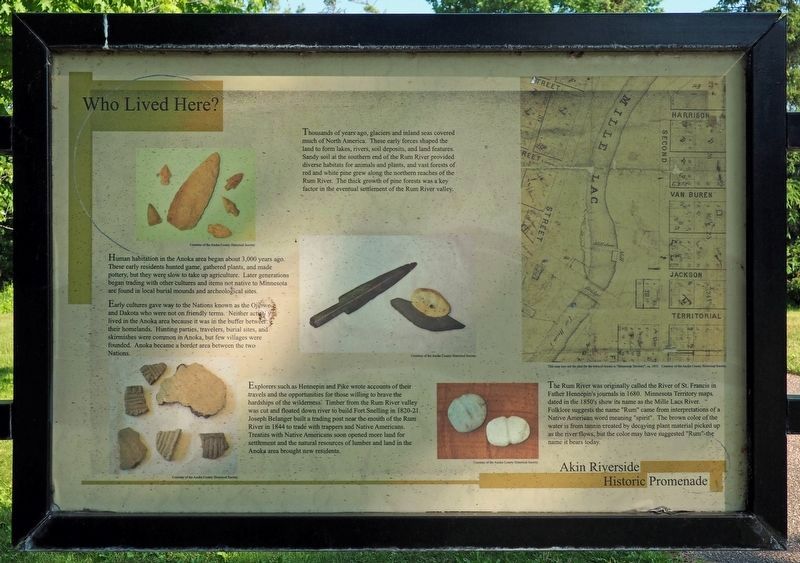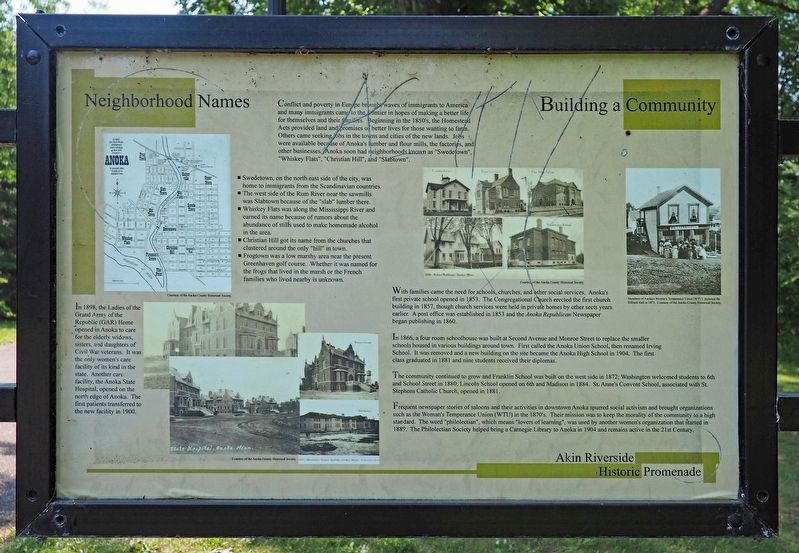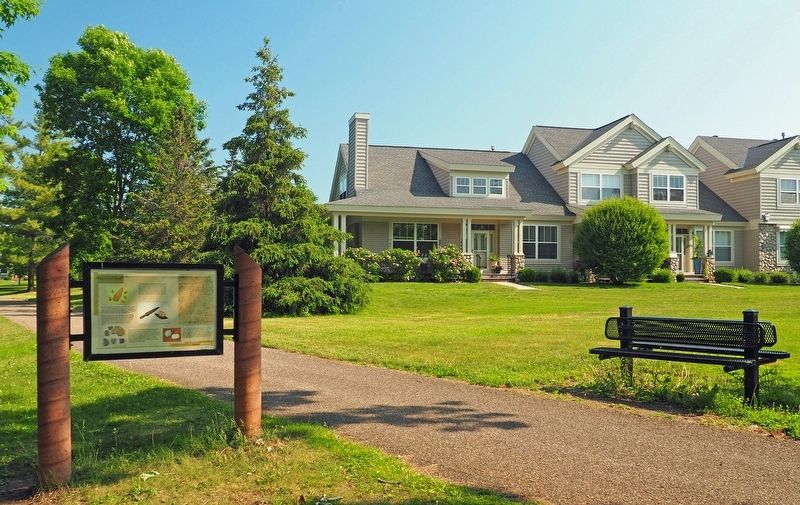Anoka in Anoka County, Minnesota — The American Midwest (Upper Plains)
Who Lived Here / Neighborhood Names / Building a Community
— Akin Riverside Historic Promenade —
Who Lived Here
Thousands of years ago, glaciers and inland seas covered much of North America. These early forces shaped the land to form lakes, rives, soil deposits, and land features. Sandy soil at the southern end of the Rum River provided diverse habitats for animals and plants, and vast forests of red and white pine grew along the northern reaches of the Rum River. The thick growth of pine forests was a key factor in the eventual settlement of the Rum River valley.
Human habitation in the Anoka area began about 3,000 years ago. These early residents hunted game, gathered plants, and made pottery, but they were slow to take up agriculture. Later generations began trading with other cultures and items not native to Minnesota are found in local burial mounds and archeological sites.
Early cultures gave way to the Nations known as the Ojibwe and Dakota who were not on friendly terms. Neither actively lived in the Anoka area because it was in the buffer between their homelands. Hunting parties, travelers, burial sites, and skirmishes were common in Anoka, but few villages were founded. Anoka became a border area between the two Nations.
Explorers such as Hennepin and Pike wrote accounts of their travels and the opportunities for those willing to brave the hardships of the wilderness. Timber from the Rum River valley was cut and floated down river to build Fort Snelling in 1820-21. Joseph Belanger built a trading post near the mouth of the Rum River in 1844 to trade with trappers and Native Americans. Treaties with Native Americans soon opened more land for settlement and the natural resources of lumber and land in the Anoka area brought new residents.
The Rum River was originally called the River of St. Francis in Father Hennepin's journals in 1680. Minnesota Territory maps dated in the 1850's show its name as the Mille Lacs River. Folklore suggests the name "Rum" came from interpretations of a Native American word meaning "spirit". The brown color of the water is from tannin created by decaying plant material picked up as the river flows, but the color may have suggested "Rum"-the name it bears today.
Neighborhood Names
Conflict and poverty in Europe brought waves of immigrants to America and many immigrants came to the frontier in hopes of making a better life for themselves and their families. Beginning in the 1850's, the Homestead Acts provided land and promises of better lives for those wanting to farm. Others came seeking jobs in the towns and cities of the new lands. Jobs were available because of Anoka's lumber and flour mills, the factories, and other businesses. Anoka soon had neighborhoods known as "Swedetown", "Whiskey
Flats", "Christian Hill", and "Slabtown".
• Swedetown, on the north east side of the city, was home to immigrants from the Scandinavian countries
• The west side of the Rum River near the sawmills was Slabtown because of the "slab" lumber there.
• Whiskey Flats was along the Mississippi River and earned its name because of rumors about the abundance of stills used to make homemade alcohol in the area.
• Christian Hill got is name from the churches that clustered around the only "hill" in town.
• Frogtown was a low marshy area near the present Greenhaven golf course. Whether it was named for the frogs that lived in the marsh or the French families who lived nearby is unknown.
In 1898, the Ladies of the Grand Army of the Republic (GAR) Home opened in Anoka to care for the elderly widows, sisters, and daughters of Civil War veterans. It was the only women's care facility of its kind in the state. Another care facility, the Anoka State Hospital, opened on the north edge of Anoka. The first patients transferred to the new facility in 1900.
Building a Community
With families came the need for schools, churches, and other social services. Anoka's first private school opened in 1853. The Congregational Church erected the first church building in 1857, though church services were held in private homes by other sects years earlier. A post office was established in 1853 and the Anoka Republican Newspaper began publishing in 1860.
In 1866, a four room schoolhouse was built at Second Avenue and Monroe Street to replace the smaller schools housed in various buildings around town. First called the Anoka Union School, then renamed Irving School. It was removed and a new building on the site became the Anoka High School in 1904. The first class graduated in 1881 and nine students received their diploma.
The community continued to grow and Franklin School was built on the west side in 1872; Washington welcomed students to 6th and School Street in 1880; Lincoln School opened on 6th and Madison in 1884. St. Anne's Convent School, associated with St. Stephens Catholic Church, opened in 1881.
Frequent newspaper stories of saloons and their activities in downtown Anoka spurred social activism and brought organizations such as the Woman's Temperance Union (WTU) in the 1870's. Their mission was to keep the morality of the community to a high standard. The word "philolectian", which means "lovers of learning", was used by another women's organization that started in 1889. The Philolectian Society helped bring a Carnegie Library to Anoka in 1904 and remains active in the 21st Century.
Members of Anoka's Women's Temperance Union (WTU) picketed the Billiard Hall in 1873.
Topics. This historical marker is listed in these topic lists: Education • Immigration • Native Americans • Settlements & Settlers. A significant historical year for this entry is 1844.
Location. 45° 11.598′ N, 93° 23.449′ W. Marker is in Anoka, Minnesota, in Anoka County. Marker can be reached from 2nd Avenue west of Rivers Pointe Court. The marker is on the Akin Riverside Historic Promenade, a block north of the southern trailhead. Touch for map. Marker is at or near this postal address: 1521 2nd Avenue, Anoka MN 55303, United States of America. Touch for directions.
Other nearby markers. At least 8 other markers are within walking distance of this marker. Where Cultures Meet (about 600 feet away, measured in a direct line); Fireman's Grove (about 700 feet away); Logbooms Meet Sawmills (about 700 feet away); Bridging the Mississippi (about 800 feet away); Ticknor House (approx. 0.2 miles away); Where Land and Water Meet (approx. 0.2 miles away); River Highways (approx. 0.2 miles away); Highway of Exploration (approx. 0.2 miles away). Touch for a list and map of all markers in Anoka.
Credits. This page was last revised on November 27, 2023. It was originally submitted on November 26, 2023, by McGhiever of Minneapolis, Minnesota. This page has been viewed 59 times since then and 28 times this year. Photos: 1, 2, 3. submitted on November 26, 2023, by McGhiever of Minneapolis, Minnesota. • J. Makali Bruton was the editor who published this page.


